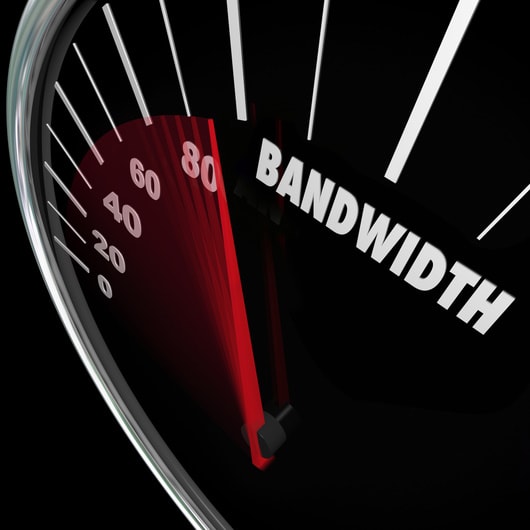
Table of Contents
Internet Speed vs. Bandwidth: What’s the Difference?
The distinction between internet connection speed and bandwidth lies in the fact that while internet speed refers to the rate at which data is transferred over a network, bandwidth refers to the capacity of the network to transfer data, thus leaving users with limited options when it comes to choosing an appropriate plan.
Internet speed is often measured using an internet speed test, which calculates the time it takes for data packets to travel from one point to another. It is typically expressed in megabits per second: Mbps or gigabits per second: Gbps. Higher internet speeds allow for faster downloads and uploads, smoother streaming of videos and music, and better overall performance of online activities. On the other hand, bandwidth represents how much data can be transmitted over a network within a given period of time. It is usually measured in terms of bits per second: bps, kilobits per second: Kbps, or megabits per second (Mbps). Bandwidth determines how much information can be sent simultaneously through an internet connection. A higher bandwidth means more data can be transmitted at once, resulting in faster transfer rates and improved user experience.
Importance of Internet Speed and Bandwidth
Internet speed and bandwidth are crucial factors that directly impact the quality of your online experience. Here’s why they are important:
Efficient Data Transfer
High internet speed and sufficient bandwidth allow for faster and smoother data transfer. This is particularly important for activities such as downloading files, streaming videos, online gaming, and video conferencing. Faster speeds result in reduced buffering times and improved real-time interactions.
Streaming and Media Consumption
Adequate internet speed and bandwidth are essential for streaming high-definition (HD) and ultra-high-definition (UHD) videos without interruptions or quality degradation. Insufficient speed can lead to buffering, lower resolution, and poor audio-video synchronization.
Online Gaming
Online gaming requires a stable and fast internet connection to minimize lag and provide a seamless gaming experience. Low latency, which is influenced by both speed and bandwidth, is crucial for real-time interactions in multiplayer games.
Cloud Services and Data Backup
For businesses and individuals using cloud services or backing up data to remote servers, higher internet speed and bandwidth contribute to quicker uploads and downloads. This is essential for efficient data management and disaster recovery.
Productivity and Remote Work
As remote work and online collaboration become more common, a strong internet connection with sufficient speed and bandwidth is crucial for video conferencing, sharing large files, and accessing cloud-based tools and applications. A practical example is countries with the fastest internet experience a higher production due to efficient remort jobs.
How To Measure Internet Speed
Measuring internet speed can be done using various online tools and methods. One of the most common methods involves using internet speed test websites. These websites provide a simple interface where you can initiate a test that measures your download and upload speeds, as well as your ping or latency. Popular speed test websites include Ookla’s Speedtest.net, Fast.com by Netflix, and Google’s Measurement Lab (M-Lab). To perform a test, you typically just need to visit one of these websites and click the “Start Test” button. The website will then send and receive data to measure your connection’s speed and provide results in terms of Mbps (megabits per second) for download and upload speeds, and milliseconds for ping.

This is important:
It’s important to note that internet speeds can vary throughout the day due to factors like network congestion and the number of devices connected to your network. To get accurate results, it’s recommended to perform multiple tests at different times. Additionally, performing the tests on a wired connection rather than Wi-Fi can provide more consistent and accurate results, as Wi-Fi signals can be affected by interference and distance from the router.How to Measure Internet Bandwidth
Measuring internet bandwidth involves assessing how fast data is transferred over a period. One effective way to measure bandwidth is to use a bandwidth testing tool. These tools usually work by downloading and uploading large files to and from a remote server. By monitoring the time it takes to transfer these files, the tool calculates the effective bandwidth of your connection in Mbps (megabits per second). Some popular bandwidth testing tools include iPerf, NetWorx, and Cisco’s TRACERT command. To use these tools, you typically need to install them on your computer and follow the provided instructions to initiate the tests. It’s advisable to run multiple tests at different times to obtain a more accurate average measurement, as bandwidth can fluctuate due to network congestion and other factors. Utilize bandwidth monitoring to gain insights into your speed and bandwidth requirements over time. This practice involves gathering real-time usage information throughout your network.

Note:
Keep in mind that the measured bandwidth might not always match the speed advertised by your Internet Service Provider (ISP). Various factors, such as network overhead, server limitations, and other devices on your network, can affect the observed bandwidth. Also, remember that bandwidth is the theoretical maximum capacity of your connection, while the actual internet speed you experience might be lower due to factors like latency and network congestion.Best Internet Plans for Speed and Bandwidth
Top Internet Packages for Speed and Bandwidth
Xfinity Connect
Opt for Xfinity’s Connect More plan for an impressive combination of bandwidth and speed. With medium bandwidth capacity and a blazing 200Mbps speed, this plan offers excellent value at just $35.00 per month
Spectrum Internet
Spectrum presents a robust option with its Internet® 300 Mbps package. With medium bandwidth capacity and network speed of up to 300Mbps (wireless speeds may vary), this plan comes at a competitive price of $49.99 per month for 12 months.
Verizon Internet
Verizon’s Internet 300/300 plan strikes a balance between capacity and swiftness. Boasting a medium bandwidth capacity and a rapid 300Mbps speed, this plan is attractively priced at just $24.99 per month.
Google Fiber
If you’re in pursuit of extraordinary speed and bandwidth, Google Fiber’s 1 Gig plan offers exceptional value. With an extremely high bandwidth capacity and speeds of up to 1,000Mbps, this plan is available at $70.00 per month§.
AT&T Internet
For an internet experience that defies limits, consider AT&T’s Internet 5000 plan. Offering speeds of up to a staggering 5,000Mbps, this plan is akin to the force of the Hoover Dam without the constraints. At $180.00 per month. This plan is designed for those who demand unparalleled speed.
Types of the Internet With the Most Bandwidth
Several types of internet technologies offer high bandwidth capabilities. Here are some of the types of internet connections known for providing the most bandwidth:
Fiber Optic Internet
Fiber optic internet offers the fastest connection speed with the most high bandwidth in the options available. It uses thin strands of glass or plastic to transmit data using light signals. Fiber optic connections can provide symmetrical speeds, meaning the upload speed matches the download speed. Gigabit and multi-gigabit speeds are common with fiber optic connections, offering incredibly high bandwidth for both residential and business users. Learn about the best fiber internet providers from Security Gladiators.

Cable Internet
Cable internet utilizes coaxial cables to deliver internet service. It offers higher bandwidth compared to traditional DSL connections. While cable speeds can vary based on the service plan and network congestion, many cable providers offer plans with speeds in the hundreds of Mbps range, making it a suitable choice for high-bandwidth activities like streaming and online gaming.
Fixed Wireless Internet
Fixed wireless internet involves transmitting data between two fixed points using radio signals. This technology has evolved to offer high bandwidth, especially in areas where traditional wired options are limited. Fixed wireless providers can offer speeds in the range of hundreds of Mbps, and in some cases, even gigabit speeds.
Satellite Internet (High Throughput Satellites)
Traditional satellite internet had limitations in terms of bandwidth due to the distance signals needed to travel. However, advancements in satellite technology, like High Throughput Satellites (HTS), have significantly increased satellite internet speeds and bandwidth. While satellite connections can still have higher latency compared to other types of connections, they can offer respectable speeds in areas where wired options are unavailable.
5G Wireless Networks
5G wireless networks promise high-speed and high-bandwidth connectivity. While primarily associated with mobile devices, 5G technology can also be used to provide home internet services. In urban areas with strong 5G coverage, users can experience gigabit-level speeds, making it a high-bandwidth option.
Internet Activities That Use the Most Bandwidth
Here are some of the internet activities that consume a substantial amount of bandwidth:
Video Streaming
Streaming services such as Netflix or YouTube require a significant amount of bandwidth to deliver high-quality video content. The video files are continuously downloaded from a remote server and played in real time on the user’s device. The higher the resolution of the video, the more data is transferred, resulting in greater bandwidth consumption.
Online Gaming
Online multiplayer games involve real-time communication between players and constant data exchange with remote servers. This requires a stable and fast internet connection to ensure smooth gameplay without lag or delays. Online gaming can be particularly demanding for bandwidth due to the constant flow of data between players and servers.
Large File Sharing
Uploading or downloading large files, such as high-resolution images or videos, can significantly impact bandwidth usage. When sharing these files through platforms like cloud storage or file-sharing websites, both uploading and downloading consume considerable amounts of bandwidth.
Video Conferencing
Video conferencing platforms like Zoom, Microsoft Teams, and Google Meet require a consistent and reliable connection for high-quality video and audio. Video calls can consume a significant amount of bandwidth, especially when multiple participants are using video simultaneously. To know how much bandwidth you require for your organization, it is important to study the tests done before and compare them to your internet.
Cloud Backup and Sync
Uploading and syncing data to cloud storage services such as Google Drive, Dropbox, and iCloud can use considerable bandwidth, especially when transferring large files or syncing changes across multiple devices.
Large File Downloads and Uploads
Downloading or uploading large files, such as software installations, high-resolution images, and videos, can strain bandwidth. This is particularly relevant for creative professionals, content creators, and businesses that handle large media files.
Software and Game Updates
Software updates for operating systems, applications, and games can be sizable. Updates often include new features, bug fixes, and security patches, and they can trigger significant bandwidth usage when downloaded.
Streaming Music
While not as bandwidth-intensive as video streaming, streaming high-quality music on platforms like Spotify, Apple Music, and Tidal can still consume a notable amount of data, especially if you’re streaming for extended periods.
Frequently Asked Questions
What Are the Factors That Can Affect Internet Speed and Bandwidth?
Firstly, the type of internet connection plays a crucial role. Broadband connections like fiber optic or cable generally offer higher speeds compared to dial-up or satellite connections. Secondly, network congestion can impact internet speed, especially during peak usage hours when many users are accessing the same network simultaneously. Additionally, the quality and capacity of the hardware and infrastructure used by both the internet service provider (ISP) and the user can influence speed and bandwidth. Outdated equipment or faulty cables may result in slower connections.
Can I Have High Internet Speed but Low Bandwidth, or Vice Versa?
Yes, it is possible to have high internet speed but low bandwidth, or vice versa. While both terms are related to data transmission, they represent different aspects of network performance. High internet speed indicates a fast transfer rate of data packets between devices, allowing for quick loading times and smooth browsing experiences. However, if the available bandwidth is limited, this high-speed connection may not be able to handle large amounts of data simultaneously. Conversely, having low internet speed means slower transfer rates but does not necessarily indicate limited bandwidth capacity.
How Does Latency Affect Internet Speed and Bandwidth?
Latency refers to the delay experienced when data packets are transmitted from one point to another over a network. In terms of internet speed, latency can decrease the overall speed by increasing the time it takes for data to travel back and forth between the source and destination. This delay can lead to slower loading times, buffering issues, and reduced real-time communication quality. Latency affects bandwidth by reducing its effective utilization. When there is high latency, it takes longer for data packets to reach their destination and receive acknowledgment before more packets can be sent, thus reducing the available bandwidth for transmitting additional information.
What Are Some Common Misconceptions About Internet Speed and Bandwidth?
One common misconception is that internet speed and bandwidth are the same thing. While they are related, they are not interchangeable terms. Another misconception is that increasing bandwidth automatically leads to faster internet speeds. While having more bandwidth can potentially increase the speed at which data is transferred, it does not guarantee faster internet speeds if other factors such as server limitations or network congestion exist. Additionally, some users may mistakenly assume that their internet service provider’s advertised speeds represent their actual achievable speeds when various factors like network traffic and distance from servers can impact the actual performance experienced by users.
What Is the Difference Between Network Throughput and Bandwidth
Network throughput refers to the actual rate of data transfer between two points in a network and represents the effective data transfer capacity in real-world scenarios. Bandwidth, on the other hand, signifies the maximum throughput a network or connection can handle under ideal conditions, indicating its potential capacity without considering factors like latency or network congestion.
Conclusion
Understanding the difference between internet speed and bandwidth is crucial for optimizing internet usage. While internet speed refers to the rate at which data is transmitted, bandwidth represents the maximum amount of data that can be transmitted in a given time period. Both factors are essential for determining the efficiency and performance of an internet connection. It is important to consider factors such as household size, online activities, and budget when choosing an appropriate plan. Comprehending the nuances between internet speed and bandwidth empowers individuals to make informed choices about their internet services based on their specific needs and preferences. By understanding how these factors impact connectivity and performance, users can optimize their online experiences and maximize productivity in today’s digital world.

